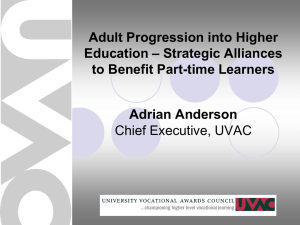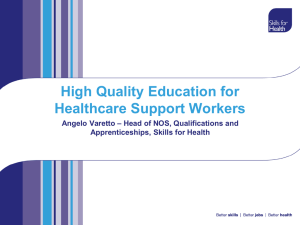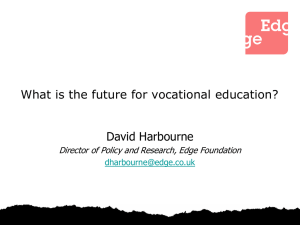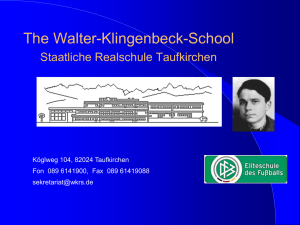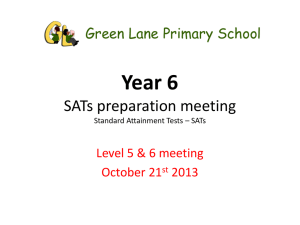Master Power Point June 24 2014 Data Pack Lite Final
advertisement
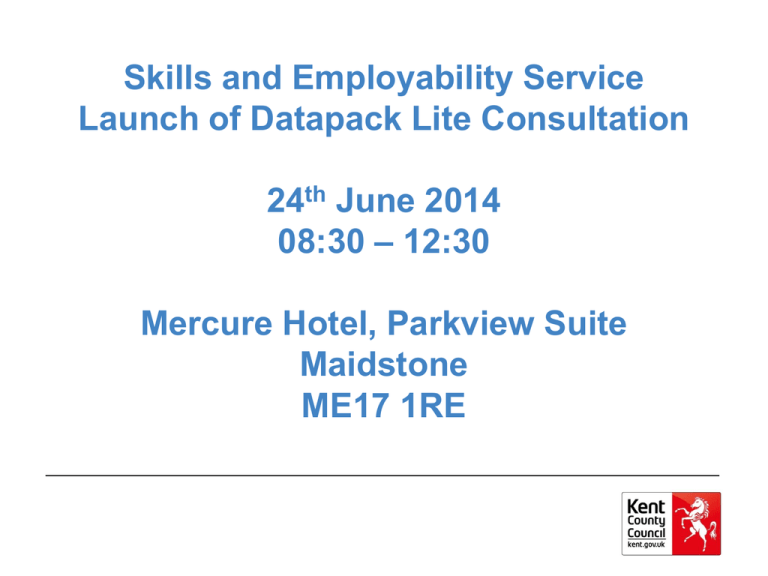
Skills and Employability Service Launch of Datapack Lite Consultation 24th June 2014 08:30 – 12:30 Mercure Hotel, Parkview Suite Maidstone ME17 1RE Datapack Lite – Consultation Launch June 24th 2014 16-19 Year-Olds Participating in Full-Time Education / Apprenticeships (excluding HE) Vocational Students 21% Apprentices 9% Higher achieving vocational students 21% Employers report… • difficulties recruiting workers with technical and STEM skills (39%) (CBI, 2013). • school and college leavers lack basic numeracy (32%), literacy (31%), and experience (55%). Post-16 Curriculum and Funding Reforms Since August 2013, all 16-19 year-olds have been following study programmes based on their prior attainment at KS4 and focused on enabling them to achieve their learning and career ambitions. The components are set out below: Substantial qualification (academic or vocational) Meaningful work experience PROGRESSION TO FURTHER STUDY AND EMPLOYMENT English and maths to GCSE A*-C (for those without this) Other non-qualification or ‘enrichment’ activities DRIVERS • • • • • • • • • Destination measures 16 – 18 performance tables Ofsted inspections Funding per student Minimum standards EFA monitoring CEIAG Institutional sustainability Opportunities for curriculum re-design Careers Advice and Guidance Challenge: Ofsted’s review of careers guidance found that only one in five schools ensured their pupils were receiving effective support. • • • • Way forward: In September 2013, we published an inspiration vision, which recognises that modern careers guidance is about inspiration as much as advice, and that schools should have closer links with employers to give pupils real insight into the world of work. To achieve this we have: Revised statutory guidance to set clearer expectations of schools. This was published in April 2014, accompanied by an advice document with a number of case studies of good practice for schools to draw on. Strengthened Destination Measures, which show where pupils go on to after school. These now include employment destinations and we are making further improvements this year. Giving the National Careers Service a greater role in local partnership working, to increase contacts between schools and employers. This forms a key part of new contracts which begin in October 2014. 16-19 Accountability Reforms There will be five headline measures in 2016 Tables: • Destinations - what students do when they leave the provider. • Retention – the percentage of students who complete their core programme. • English and maths – showing the progress of those who did not achieve a C at Key Stage 4. • Progress – the progress students make while at school/college. • Attainment – how well students attain. • There will also be a range of ‘additional measures’ sitting below the headline measures and a wealth of subject/gender/grade information sitting below that. • Expanding the tables to include outcomes below level 3 from 2017 Transforming Opportunities General Qualifications Reform GCSEs • Reviewed subject content to ensure breadth and depth • Greater focus on key skills such as numeracy and literacy • An end to modularity and a reduction in non examination assessment • A reduction in the use of tiered exams where possible A levels • A levels to be linear with more synoptic assessment and all assessment at the end of two years. • A level content redeveloped in line with the Mark Smith report to ensure the qualification adequately prepares students for degree-level study. • Universities advising on maths, geography and languages A levels. • AS will be decoupled from the A level, so that the marks do not count towards the final A level grade. • General Qualifications Reform Transforming Opportunities Substantial Vocational Qualifications and KS5 Reform • Vocational education still seen as a poor second to academic study; • Skills shortages are holding back competitiveness and growth; • Most vocational qualifications don’t lead to skilled employment. From 2016: • Level 3 vocational qualifications reported in performance tables will need to demonstrate challenging new characteristics and will be restricted to: • ‘Technical’ qualifications – for students who have a clear idea about an occupation they wish to pursue and are already ready to specialise; • ‘Applied General’ qualifications – for students who wish to continue their education and learn in an applied way. Applied General Qualifications • For students wishing to continue their general education at Advanced level through applied learning. • Equip a student with transferable knowledge and skills. • Fulfil entry requirements for a range of higher education courses, either by meeting entry requirements in their own right or being accepted alongside other qualifications at the same level. • They may also enable entry to employment or an apprenticeship Transforming Opportunities Tech Levels • For students wishing to specialise in an occupation or occupational group. • Equip a student with specialist knowledge and skills. • Enable entry to employment or an apprenticeship in that occupational group or progression to a related further or higher education course. • In some cases they can provide a ‘licence to practise’ or exemption from professional exams. • Tech Levels cover most vocational subject areas (with agriculture, horticulture, animal care, and manufacturing technologies strongly represented). NEW! Tech Awards Approved list of level 2 substantial vocational qualifications • As we have done at level 3, we propose to publish an approved list of high quality substantial vocational qualifications at level 2. • SUBSTANTIAL VOCATIONAL QUALIFICATIONS at level 2 provide students aged 16 to 19 with a route into a skilled trade or occupation, where employers recognise entry at this level (e.g. most construction trades, care work and hairdressing). They will also provide access to Tech Levels • •Only these level 2 qualifications will be recognised within the top line performance tables. We propose that this list will apply to students starting level 2 courses in September 2015. Maths and English: Policy Ambitions • Everyone should leave education equipped with the skills to get a good job, a place at university, or an Apprenticeship. • Good maths and English are essential for every job. • From August 2014 students without A*-C must study GCSE or approved ‘stepping stone’ qualifications as a condition of funding. • To support existing expectations, full-time students with a grade D enrolling from August 2015 and beyond will need to study GCSE and not stepping stone qualifications. (NB: does not apply to Traineeships/Apprenticeships). • Reformed GCSEs are expected to become the national standard qualification at level 2 in English and maths from 2017. Maths and English in Kent schools Achievement post 16 • Source: Success Rate Data 2012 – 2013 English Maths Kent % National % Kent % National % A* - C 14.0 13.8 13.3 15.6 D-G 55.5 48.9 60.0 54.9 pass 69.5 62.8 72.9 70.5 fail 30.5 37.2 29.3 29.5 The extent of the challenge…in 2013 • 12 schools (out of 42) had no students achieving A* C English. • 1 school had no English passes at all • 8 schools had no students achieving A* - C Maths. • 1 school had no Maths passes at all • Only 2 schools had double digit A* - C passes • 20 schools had below the national average13.8% English A* - C rate. • 27 schools had below the national average Maths 15.6% A* - C rate. progression National at age 16 2011 Latest Establishment Post 16 Prior attainment at age 16 Same School Below Level 1 Level 1, below Level 2 Level 2 without English and Maths Level 2 incl Eng and Maths All Pupils Another School or Sixth Form Below Level 1 College within this LA Level 1, below Level 2 Level 2 without English and Maths Level 2 incl Eng and Maths All Pupils FE College within this LA Below Level 1 Level 1, below Level 2 Level 2 without English and Maths Level 2 incl Eng and Maths All Pupils Percentage of Learners by age 19 attaining by 2013 Level 1 Level 2 Level 3 No further Total or or or qualifications Learners above above above Post 16 5207 27.0 18.7 11.1 29.7 5859 99.9 65.6 33.5 7.2 13167 100.0 100.0 58.4 6.3 128239 100.0 100.0 92.1 0.5 152472 97.5 95.9 84.1 2.2 1481 50.4 35.7 21.7 23.4 3927 100.0 73.5 40.6 3.0 5312 100.0 100.0 60.2 3.6 62422 100.0 100.0 92.3 0.4 73142 99.0 97.3 85.8 1.2 10295 57.0 23.6 4.1 19.7 42261 100.0 63.5 17.9 3.6 37753 100.0 100.0 38.6 2.0 59784 100.0 100.0 76.0 0.6 150093 97.0 84.5 45.3 3.1 Retention % 2012 – 2013 Previous Year 12 Retention Year 12 Retention Transition Retention Kent National Grammar Schools Wide Ability High LPUK – retention types 93 94 97 91 91 95 94 98 93 91 87 86 91 80 86 77 77 87 69 70 96 95 99 94 93 Overall Retention In-Year Retention Sustainability A number of factors undermining performance at Advanced Level are linked to the size of the Sixth Form and the curriculum offer. • Evidence suggests a clear correlation between the size of sixth form and the outcomes achieved. • It suggests that Sixth Forms need to be of a large enough size to offer students a breadth of curriculum that allows them to select appropriate subjects and to be in groups that generate an appropriate learning environment. • A small sixth form has fewer than 100 students. • A viable sixth form will have approximately 150 pupils and small sixth forms are a financial drain on the school, so there are implications for standards in KS3 and KS4. • However small sixth forms can be successful with a focus on vocational and technical courses. OFSTED Ofsted will be grading sixth form provision in schools from September 2014. Their expectations are: • Offer: learners’ progress to a level higher than prior attainment with breadth, depth and substantial qualification outcome; • Content: relevant to learners’ planned next step • English and mathematic: opportunities to work towards grade C or above; • Leadership: identified leadership and accountability for the quality of provision and outcomes OFSTED Ofsted will consider: • the quality of teaching, learning and assessment, including: the monitoring, review and achievement of challenging targets set; • securing opportunities to contextualise learning and ensuring the relevance and validity of opportunities for practical application of skills; • the effectiveness of arrangements to secure well-managed individual programmes opportunities for learners to make a real contribution in the workplace as they develop their skills • the clarity and impact of communication links between education and work-place settings to ensure every learner achieves their potential OFSTED Providers will need to consider: • strategies to engage employers and promote the value-added by engaging in the provision staff skills and expertise, identifying staff training needs; • the potential for partnership working with other providers to enhance learning; • the identification of appropriate alternative English and • mathematics qualifications to support the transition to • GCSE over a longer period of time. Post 16 data report 2013 This report covers: • Headline indicators • Gender, SEN, FSM • Minimum Standards • Progress • Value Added • Retention This will be available on KELSI and will be sent to schools. Next Steps • Develop further local collaboration between providers as part of local 14-19 partnerships • Continue to improve KS4 performance • Develop new and better learning pathways and provision including vocational qualifications • Extend the apprenticeship offer • Take more action to reduce Year 12 drop out rate • Provide more support and better provision for vulnerable learners • Continue to make better use of the data to re-design the curriculum offer The Datapack Lite Consultation June 24th 2014 Aims • Summarise key legislative changes that have occurred which impact upon post-16 learning. • To revisit the analysis of district economies. • To review changes made to the curriculum over the last year. • To illustrate the impact on participation, attainment and progression. • To set the scene for developing the 2015/2016 curriculum. Structure • • • • • • • Introduction Executive Summary National Agenda The Economic Landscape The Local Offer Participation Learning Plus UK’s Dashboard Consultation Feedback from main data pack • Head teachers needs • Colleges feeling that it was too focussed on schools Learners • are all their needs met • do they have progression pathways to employment Sonia McCluskey SET Training Catrin Woodend Head Teacher The Abbey School Faversham Rebecca O’Neill Brogdale CIC Using the Data Pack to meet the needs of vulnerable learners: the Nacro partnership Simon Bounds Using the Data Pack • NEET hotspots and reasons: Swale & Ashford • Provision Gap: foundation learning, “preapprenticeship” • Provision gap: “learner-centred” programmes using new study programme structure and funding • Areas of possible future employment • Information informed gaps analysis to the EFA The Context • Nacro using their national EFA allocation • NB could be increased through sub-contracting collaboration with local schools/ colleges • Qualitative Research into the needs and interests of the NEET groups (CXK & NEET 2 EET) • Use of networks to: – Recruit learners (NEET 2 EET) – Create links with the right agencies – Develop progression Vulnerable Learner Groups Involved • • • • • Young Offenders Students with statements- especially EBD Those at the PRU NEETs at level 1 or below Looked After Children Study Programme 1: AWEP, Restoration Youth, Sheerness Core Aim: Foundations for Learning & Life; Work Experience Internal Work Experience ASDAN Employability Duke of Edinburgh Bronze External Work Experience Functional Skills E2- L1 Weekly Reflection on Progress and IAG Personal & Social development e.g. health & fitness training Study Programme 2: Brogdale CIC, Faversham & Ashford Core Aim: Work Experience External Work Experience ASDAN Employability Duke of Edinburgh Bronze Introduction to Horticulture Functional Skills E2- L1 IAG with particular emphasis on the local horticulture and agriculture FE and employment sector Personal & Social development Study Programme 3: Alternative Creative, Ashford Core Aim: Qualifications TBC External Work Experience Bronze and Silver Arts Award Rock school (NVQ) Level 1, 2 and 3 Industry trips and events organisation e.g. Functional Skills E3- L1 Lounge on the Farm festival, Liverpool city GCSE, next year with Towers school of culture IAG: instilling realism, pathway to future FE/ HE courses, self-employment and entrepreneurship Progression to their Level 2 and 3 Creative apprenticeships Personal & Social development quals L1 & L2: raising aspirations, independent living skills for LAC, focus on travelling to where the work is- Canterbury, London… What Is Collaboration? Jonathan Smith Drivers • • • • • • 14-24 Skills and Employability Strategy Destination measures Moral purpose for joint delivery Ofsted Management and Leadership Falling rolls / size of KS5 Progression issues KS4 – KS5 vocational programmes • Lack of provision for level 1 • RPA • Narrowing the gap Definition of Need • • • • • • • • Setting the Direction for Economic Growth Data Pack Support Reducing NEETs Pathways for Vulnerable Learner LLD CIC Alternative Provision/PRU BESD Develop New Provision • • • • • • High quality blended academic and vocational 2-1-2 Model Pre Apprenticeship Pathways Apprenticeship pathways 14-19 progression pathways Ranging from level 1 - 4 Profile of Provision • Collectively look at developing solutions that will overcome barriers by: • Developing a joint delivery approach to Key Stage 5 with an offer that encourages retention and attainment at all levels, and a clear progression to FE, HE and employment • Focusing particular attention on the attainment of learners who are below level 1, level 1 and level 2 without English and Maths at age 16 • Raising the aspirations of all Kent learners What is Needed • Student centred approach to planning taking into account individual needs and aspirations starting in year 9 • Focus on achieving goals rather than focusing on specific provision • A commitment to provide a local solution wherever possible • Not limited by what is already available- look at social enterprise companies/activities, employers, training providers, maintained and non maintained schools special and mainstream schools, FE Colleges. • Pick and Mix 2-1-2 model of delivery • Creative knowledge of the district providers • Combining strengths of different types of providers to give best solution to students • Curriculum that matches local labour need Models Traineeship model 16-24 School English/maths Literacy/numeracy FE College/Nacro Training etc. Provider/employers Health Social care Work Experience Electric Engineering Catering 14-16 Secondary School/Skills FE College Centre English/Maths/ICT Health & Social care Electric Engineering Catering Training Providers/employers Work Experience Tech level models 16-19 Secondary School/Skills FE College Centre Maths/English Technical Literacy/numeracy Qualification Training Providers/employers WRL Work Experience Maths/English/Science WRL Work Experience STEM technical Skills and Employability Service Launch of Datapack Lite Consultation 24th June 2014 08:30 – 12:30 Mercure Hotel, Parkview Suite Maidstone ME17 1RE


